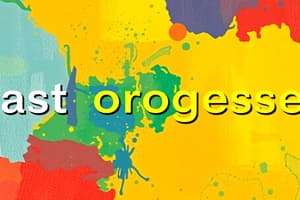Podcast
Questions and Answers
Yesterday, I ______ the museum.
Yesterday, I ______ the museum.
visited
He ______ a book last night.
He ______ a book last night.
was reading
My brother ______ a video game yesterday afternoon.
My brother ______ a video game yesterday afternoon.
was playing
We ______ on our project when the power went out.
We ______ on our project when the power went out.
Use the Simple Past tense for ______ actions or events.
Use the Simple Past tense for ______ actions or events.
The Past Progressive tense is used for ______ actions or events.
The Past Progressive tense is used for ______ actions or events.
The Past Progressive tense can add emphasis to the ongoing nature of actions or events in the ____.
The Past Progressive tense can add emphasis to the ongoing nature of actions or events in the ____.
For example, 'I was working on a project when suddenly, the power went out' implies that the power outage occurred during the project's ____.
For example, 'I was working on a project when suddenly, the power went out' implies that the power outage occurred during the project's ____.
Both tenses can be used interchangeably in some cases, but they can convey slightly different meanings.For example, both 'I visited the museum yesterday' and 'I was visiting the museum yesterday' convey that the action of visiting the museum occurred in the ____, but the latter emphasizes that the action was ongoing for a while.
Both tenses can be used interchangeably in some cases, but they can convey slightly different meanings.For example, both 'I visited the museum yesterday' and 'I was visiting the museum yesterday' convey that the action of visiting the museum occurred in the ____, but the latter emphasizes that the action was ongoing for a while.
Understanding the nuances of their usage will enable you to better convey your intended meaning and avoid mixing up ____.
Understanding the nuances of their usage will enable you to better convey your intended meaning and avoid mixing up ____.
Remember, the key to using past tenses effectively lies in accurately conveying the completed nature of actions in the Simple Past and the ongoing nature of actions in the ____.
Remember, the key to using past tenses effectively lies in accurately conveying the completed nature of actions in the Simple Past and the ongoing nature of actions in the ____.
The past tense in English includes the Simple Past and the Past _____.
The past tense in English includes the Simple Past and the Past _____.
Flashcards are hidden until you start studying
Study Notes
Understanding Past Tense in English
In the realm of tenses, English speakers often find themselves navigating the richness of the past tense. This article aims to demystify three prominent aspects of the past tense: Simple Past, Past Progressive, and usage differences.
Simple Past
The Simple Past tense is used to describe completed actions or events that happened in the past. For example:
- Yesterday, I visited the museum.
- He was reading a book last night.
The Simple Past tense is constructed by adding the past tense form of the verb to the subject. For example, in the first sentence above, "visited" is the past tense form of the verb "visit."
Past Progressive
The Past Progressive tense is used to describe actions or events that were ongoing in the past. It suggests that the action was in progress at a specific time in the past. For instance:
- My brother was playing a video game yesterday afternoon.
- We were working on our project when the power went out.
The Past Progressive tense is constructed using the verb form "to be" in the past tense (was/were) + the present participle (verb + -ing) of the main verb.
Usage Differences
When deciding between Simple Past and Past Progressive, consider the following usage differences:
-
Completed actions vs. actions in progress: Use the Simple Past tense for completed actions or events, while the Past Progressive tense is used for ongoing actions or events.
-
Emphasis: The Past Progressive tense can add emphasis to the ongoing nature of actions or events in the past. For example, "I was working on a project when suddenly, the power went out" implies that the power outage occurred during the project's progress.
-
Synonyms: Both tenses can be used interchangeably in some cases, but they can convey slightly different meanings. For example, both "I visited the museum yesterday" and "I was visiting the museum yesterday" convey that the action of visiting the museum occurred in the past, but the latter emphasizes that the action was ongoing for a while.
In summary, the past tense in English includes the Simple Past and the Past Progressive. Understanding the nuances of their usage will enable you to better convey your intended meaning and avoid mixing up tenses. Remember, the key to using past tenses effectively lies in accurately conveying the completed nature of actions in the Simple Past and the ongoing nature of actions in the Past Progressive.
Studying That Suits You
Use AI to generate personalized quizzes and flashcards to suit your learning preferences.




